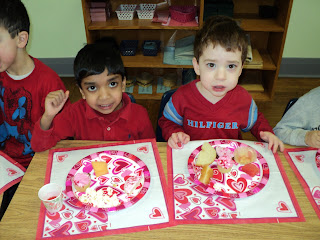Last week the following picture of President Obama had the Montessori community buzzing.
 |
| President Obama visiting the College Heights Early Childhood Learning Center in Decatur, Georgia |
I shared the picture with the children at our school during circle time. I began by asking the children if they knew who President Obama is. Many children said yes. One of our five year olds needed further clarification.
J: Excuse me Mrs. P. Do you mean Barack Obama?
Mrs. P.: Yes. President Barack Obama.
J: Oh I know him. Barack Obama is the boss of the
United States.
The rest of the children seemed to understand this. Now that we all knew exactly who we were talking about, I went around the circle showing each child the picture. I asked them to pay special attention to what President Obama was doing but not to say anything until everyone had had a chance to see the picture. Their expressions changed as they looked at the picture and saw something they recognized. Once everyone had seen the picture I asked, "What is President Obama doing?" They enthusiastically responded in unison "The Pink Tower and the Brown Stair!".
The Pink Tower and the Brown Stair (also referred to as the Broad Stair) are Montessori materials found in the Sensorial area of the classroom. The Sensorial materials were designed by Maria Montessori to offer young children concrete experiences in classifying and comparing their environment. The Sensorial materials isolate particular qualities such as colour, texture, shape, sound and weight. The Pink Tower and the Brown Stair are two separate activities. Once the child has mastered the early presentations, the materials can be combined. The President is working with an extension of these materials.
While President Obama was working with these materials, so were some of the students at our school.
While President Obama was working with these materials, so were some of the students at our school.
When the President and the children finished their work, their collective joy at a job well done was clearly evident. 
Note: President Obama and his administration are currently in the process of expanding the USA's Early Childhood Education programs as mentioned in his State of the Union address earlier in February. Although the actual program and curriculum have not been finalized, it may draw from many different philosophies of education. In 2010, President Obama nominated Dr. Margaret McLeod to join the National Board of Education. Dr. McLeod is a former Montessori teacher. The preschool shown in the pictures does not identify itself as Montessori, yet there are Montessori materials throughout the classroom.




























